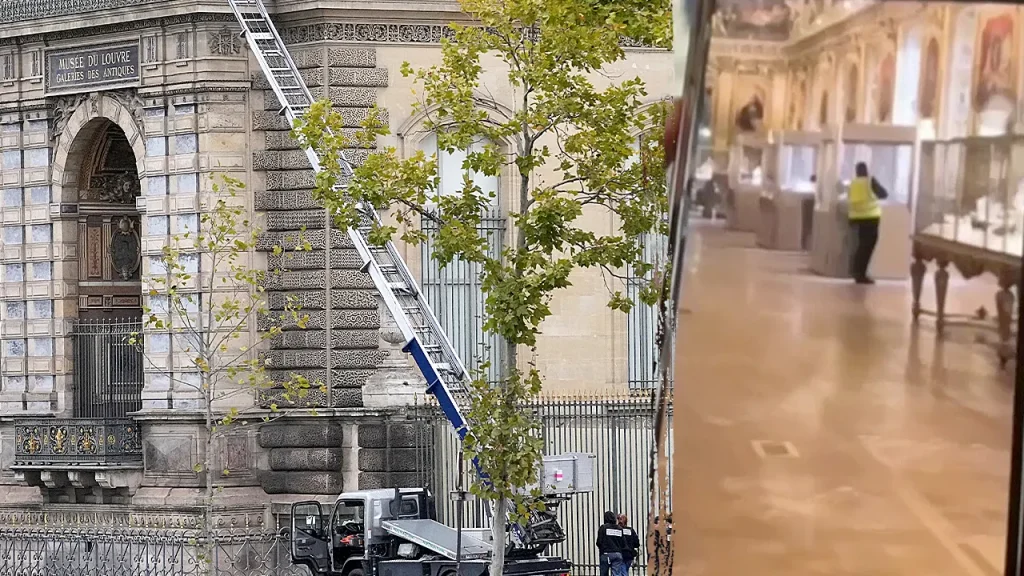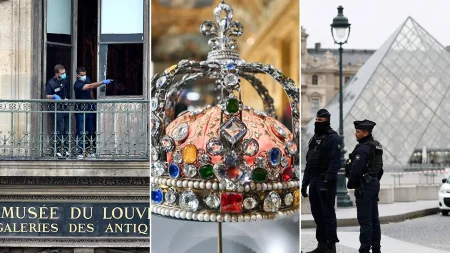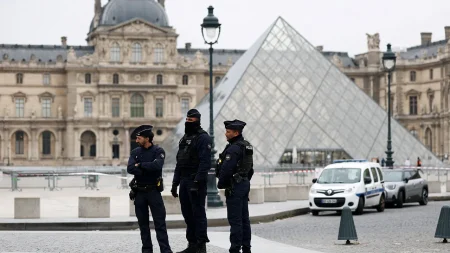Daring Daylight Heist at the Louvre: A New Video Emerges
In a stunning development that has captured worldwide attention, new footage has emerged showing what appears to be thieves in action during Sunday’s brazen daylight robbery at the Louvre Museum in Paris. The short video, obtained by French broadcaster BFMTV, offers a rare glimpse into what authorities are calling one of the most audacious art thefts in recent memory. The amateur footage shows an individual wearing a bright yellow jacket standing beside a glass display case in the museum’s prestigious Apollo Gallery, home to some of the institution’s most valuable treasures. While BFMTV has verified the video, independent confirmation of its authenticity remains pending. This visual evidence provides a chilling glimpse into the calculated precision with which the thieves executed their plan, leaving art security experts and the public alike in disbelief that such a heist could occur at one of the world’s most visited and presumably secure museums.
According to French authorities, the theft was meticulously orchestrated, unfolding with military precision just after the museum opened its doors to the public on Sunday morning. At approximately 9:30 a.m., the thieves employed a basket lift to reach the Louvre’s exterior façade, where they forcibly opened a window to gain entry into the Apollo Gallery. This particular section of the museum houses royal jewels of immense historical significance, including pieces that once belonged to Napoleon III’s court and items from Empress Eugénie’s personal collection. The boldness of the operation has stunned security experts, with former FBI Art Crime specialist Tim Carpenter noting to Fox News Digital that “These guys are fast and moving quickly with a purpose, and they breach, and they get in there really quickly.” The thieves’ ability to penetrate one of the world’s most famous museums in broad daylight speaks volumes about their preparation and determination.
Interior Minister Laurent Nuñez provided further details of the heist while speaking to radio station France Inter, confirming that the perpetrators “entered from the outside using a basket lift” and employed “a disc cutter” to slice through the protective glass panes that housed the precious jewels. This methodical approach suggests the involvement of individuals with specific technical skills and knowledge of both the museum’s layout and security protocols. The Ministry released a statement acknowledging that “a detailed list of the stolen items is being compiled” while emphasizing that “beyond their market value, these items have inestimable heritage and historical value.” This sentiment underscores a critical aspect of such thefts – while the monetary worth of the stolen pieces is undoubtedly substantial, their true value lies in their irreplaceable historical and cultural significance, representing tangible connections to France’s imperial past that cannot be quantified in mere financial terms.
The Louvre remained closed on Monday following the incident, as investigators meticulously examined the crime scene and pored over surveillance footage in hopes of identifying the perpetrators and tracing their movements before, during, and after the theft. The temporary closure of the world’s most visited museum represents not just a security measure but also a symbolic acknowledgment of the gravity of the situation. Museum officials and law enforcement agencies are now faced with the daunting task of piecing together exactly what happened and determining how such a sophisticated operation could have been executed despite the institution’s extensive security measures. The investigation will likely examine potential security lapses, insider involvement, and whether the thieves had conducted reconnaissance of the museum prior to the heist – all standard procedures in high-profile art theft cases of this magnitude.
The timing of this robbery carries additional significance as Paris prepares to host the 2024 Summer Olympics, raising concerns about security throughout the city during this high-profile international event. The theft has already sparked broader conversations about the vulnerability of cultural institutions worldwide and the evolving sophistication of art thieves who continue to target prestigious museums despite advanced security systems. Art crime experts have long noted that many high-profile thefts are commissioned by private collectors who desire specific pieces for their personal collections – items that can never be publicly displayed or sold on the legitimate market due to their notoriety. This “made-to-order” nature of certain art thefts represents a particularly challenging aspect for investigators, as the stolen items may disappear into private collections rather than resurface on the black market where they might be more easily recovered.
As the investigation unfolds in the coming days and weeks, the art world and the public will be watching closely to see whether the perpetrators are identified and if the stolen treasures can be recovered. The Louvre heist serves as a stark reminder that even the world’s most prestigious cultural institutions remain vulnerable to determined criminals. It also highlights the ongoing tension between making priceless artifacts accessible to the public while simultaneously protecting them from theft – a delicate balance that museums worldwide struggle to maintain. Beyond the immediate concerns of recovering the stolen items and bringing the thieves to justice, this incident will likely prompt a comprehensive review of security protocols at cultural institutions across France and beyond, potentially leading to significant changes in how museums protect their most valuable treasures. As one security expert noted in the aftermath of the theft, “This isn’t just about recovering stolen jewelry; it’s about protecting our shared cultural heritage for future generations.”














